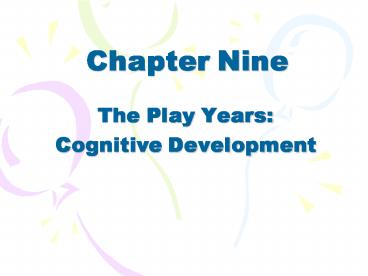Chapter Nine - PowerPoint PPT Presentation
1 / 14
Title: Chapter Nine
1
Chapter Nine
- The Play Years
- Cognitive Development
2
How Young Children Think Piaget and Vygotsky
- PiagetSwiss developmentalist
- believed young children were limited by their
egocentric perspective - egocentrismPiagets term for type of centration
in which child sees world solely from his/her
personal perspective - VygotskyRussian developmentalist
- recognized how childs social/cultural context
helps shape his/her cognitive development
3
Piaget Preoperational Thought
- Preoperational thought Piagets term for
cognitive development between 2 and 6 years - characterized by centration, focus on appearance,
static reasoning, and irreversibility - Egocentrism or ego-centration contemplation of
the world exclusively from childs personal
perspective - empathy is an exception
- Focus on appearance ignores all attributes
except appearance - Static reasoning assumes that the world is
unchanging - Irreversibility fails to recognize that
reversing a process can sometimes restore
whatever existed before transformation - Centration tendency to focus on one aspect of a
situation
4
Conservation and Logic
- Thinking is intuitive rather than logical
- Conservation principle that amount of substance
is unaffected by changes in appearance - applied to liquids, numbers, matter, length
- understanding develops after age 7, and then
slowly and unevenly
5
Conservation and Logic, cont.
6
Vygotsky Children as Apprentices
- One Theory
- theory-theory Gopniks term for the idea that
children attempt to construct a theory to explain
everything they see and hear - Children do not strive alone their efforts are
embedded in social context - parents guide young childrens cognitive growth
in many ways - present new challenges for learning
- offer assistance and instruction
- encourage interest and motivation
- Apprentice in thinking child whose intellectual
growth is stimulated and directed by older and
more skilled members of society - Guided participation process by which young
children, with the help of mentors, learn to
think by having social experiences and by
exploring their universe
7
How to Solve a Puzzle
- Guidance and motivation
- structure task to make solution more attainable
- provide motivation
- Guided participation
- partners (tutor and child) interact
- tutor sensitive and responsive to needs of child
- eventually, because of such mutuality, child able
to succeed independently
8
Scaffolding
- Scaffolding sensitive structuring of childs
participation in learning encounters - Zone of proximal development (ZPD) skills too
difficult for child to perform alone but that can
be performed with guidance and assistance of
adults or more skilled children - lower limit of ZPD can be reached independently
- upper limit of ZPD can be reached with assistance
- ZPD is a measure of learning potential
- Private speech internal dialogue when people
talk to themselves through which new ideas are
developed and reinforced - verbal interaction is a cognitive tool
- Social mediation use of speech to bridge gap
between childs current understanding and what is
almost understood
9
(No Transcript)
10
Bilingualism Should I Speak More Than One
Language?
- First Argument
- --Some argue children should become proficient in
one and only one language (monolingual ability)
will help them master a second language. - Second Argument
- --young children can master two distinct
grammars, proper word orders soon after the word
explosion. More evidence for early childhood as
a sensitive period for learning a second
language.
11
Learning Two Languages
- Two points of view
- bilingualism is an asset, even a necessity,
- child should become proficient in own 1st
language - How easy is it to be bilingual?
- many 6-year-olds have difficulty pronouncing
certain sounds - but auditory sensitivity helps young children
master pronunciation over time, a much harder
task if language learned after puberty
12
Learning Two Languages
- Best solution children become balanced
bilinguals, fluent in 2 languages - research confirms children can become equally
fluent in 2 languages - easiest way for child to become bilingual is if
parents speak 2 languages - ideally, each parent represents 1 language and
helps child with mastery - sending child to preschool where 2nd language
taught also effective
13
Early-Childhood Education
- Controversy over whether, when, and where
- Many Types of Programs
- Distinct educational curricula have been
developed - Maria Montessori (100 years ago) developed
structured, individualized projects for poor
children - Many newer programs are child-centered or
developmental - use a Piaget-inspired model that allows children
to discover at their own pace - Alternative programs stress academic readiness
- some readiness programs explicitly teach basic
school skills
14
Reggio-Emilia
- Reggio-Emilia a new form of early-childhood
education pioneered in the Italian city of that
name - children encouraged to master skills not normally
seen until age 7 - artistic expression, exploration of the
environment, and collaboration between parents
and teachers encouraged - Early childhood is the prime learning period for
every child and some learn even more - The above has led to conclusion nations should
provide quality early education - Head Start
- has provided half-day education for millions of 3
to 5 year olds, boosting abilities and skills, at
least temporarily and probably for longer































